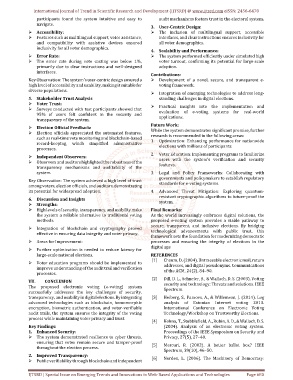Page 690 - Emerging Trends and Innovations in Web-Based Applications and Technologies
P. 690
International Journal of Trend in Scientific Research and Development (IJTSRD) @ www.ijtsrd.com eISSN: 2456-6470
participants found the system intuitive and easy to audit mechanisms fosters trust in the electoral system.
navigate.
3. User-Centric Design:
Accessibility: The inclusion of multilingual support, accessible
Features such as multilingual support, voice assistance, interfaces, and clear instructions ensures inclusivity for
and compatibility with assistive devices ensured all voter demographics.
inclusivity for all voter demographics.
4. Scalability and Performance:
Error Rate: The system performed efficiently under simulated high
The error rate during vote casting was below 1%, voter turnout, confirming its potential for large-scale
primarily due to clear instructions and well-designed adoption.
interfaces.
Contributions:
Key Observation: The system’s user-centric design ensured a Development of a novel, secure, and transparent e-
high level of accessibility and usability, making it suitable for voting framework.
diverse populations.
Integration of emerging technologies to address long-
5. Stakeholder Trust Analysis standing challenges in digital elections.
Voter Trust:
Practical insights into the implementation and
Surveys conducted with test participants showed that
evaluation of e-voting systems for real-world
95% of users felt confident in the security and
applications.
transparency of the system.
Future Work:
Election Official Feedback:
Election officials appreciated the automated features, While the system demonstrates significant promise, further
such as real-time vote monitoring and blockchain-based research is recommended in the following areas:
record-keeping, which simplified administrative 1. Optimization: Enhancing performance for nationwide
processes. elections with millions of participants.
2. Voter Education: Implementing programs to familiarize
Independent Observers: users with the system’s verification and security
Observers and auditors highlighted the robustness of the features.
transparency mechanisms and auditability of the
system. 3. Legal and Policy Frameworks: Collaborating with
governments and policymakers to establish regulatory
Key Observation: The system achieved a high level of trust
standards for e-voting systems.
among voters, election officials, and auditors, demonstrating
its potential for widespread adoption. 4. Advanced Threat Mitigation: Exploring quantum-
resistant cryptographic algorithms to future-proof the
6. Discussion and Insights
system.
Strengths:
High levels of security, transparency, and usability make Final Remarks:
the system a reliable alternative to traditional voting As the world increasingly embraces digital solutions, the
methods. proposed e-voting system provides a viable pathway to
secure, transparent, and inclusive elections. By bridging
Integration of blockchain and cryptography proved
effective in ensuring data integrity and voter privacy. technological advancements with public trust, this
framework sets the foundation for modernizing democratic
Areas for Improvement: processes and ensuring the integrity of elections in the
digital age
Further optimization is needed to reduce latency for
large-scale national elections. REFERENCES
[1] Chaum, D. (2004). Untraceable electronic mail, return
Voter education programs should be implemented to addresses, and digital pseudonyms. Communications
improve understanding of the audit trail and verification of the ACM, 24(2), 84–90.
processes.
[2] Dill, D. L., Schneier, B., & Wallach, D. S. (2003). Voting
VII. CONCLUSION
The proposed electronic voting (e-voting) system security and technology: Threats and solutions. IEEE
Spectrum.
successfully addresses the key challenges of security,
transparency, and usability in digital elections. By integrating [3] Heiberg, S., Parsovs, A., & Willemson, J. (2014). Log
advanced technologies such as blockchain, homomorphic analysis of Estonian Internet voting 2013.
encryption, biometric authentication, and voter-verifiable International Conference on Electronic Voting
audit trails, the system ensures the integrity of the voting Technology/Workshop on Trustworthy Elections.
process while maintaining voter privacy and trust.
[4] Kohno, T., Stubblefield, A., Rubin, A. D., & Wallach, D. S.
Key Findings: (2004). Analysis of an electronic voting system.
1. Enhanced Security: Proceedings of the IEEE Symposium on Security and
The system demonstrated resilience to cyber threats, Privacy, 27(5), 27–40.
ensuring that votes remain secure and tamper-proof [5] Mercuri, R. (2002). A better ballot box? IEEE
throughout the election process.
Spectrum, 39(10), 46–50.
2. Improved Transparency: [6]
Public verifiability through blockchain and independent Norden, L. (2006). The Machinery of Democracy:
IJTSRD | Special Issue on Emerging Trends and Innovations in Web-Based Applications and Technologies Page 680

